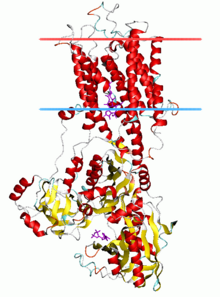 Calcium ATPase, E2-Pi state | |||||||||
| Identifiers | |||||||||
|---|---|---|---|---|---|---|---|---|---|
| Symbol | E1-E2_ATPase | ||||||||
| Pfam | PF00122 | ||||||||
| InterPro | IPR008250 | ||||||||
| PROSITE | PDOC00139 | ||||||||
| SCOP2 | 1su4 / SCOPe / SUPFAM | ||||||||
| TCDB | 3.A.3 | ||||||||
| OPM superfamily | 22 | ||||||||
| OPM protein | 3b9b | ||||||||
| Membranome | 224 | ||||||||
| |||||||||
The P-type ATPases, also known as E1-E2 ATPases, are a large group of evolutionarily related ion and lipid pumps that are found in bacteria, archaea, and eukaryotes.[1] P-type ATPases are α-helical bundle primary transporters named based upon their ability to catalyze auto- (or self-) phosphorylation (hence P) of a key conserved aspartate residue within the pump and their energy source, adenosine triphosphate (ATP). In addition, they all appear to interconvert between at least two different conformations, denoted by E1 and E2.[2] P-type ATPases fall under the P-type ATPase (P-ATPase) Superfamily (TC# 3.A.3) which, as of early 2016, includes 20 different protein families.
Most members of this transporter superfamily catalyze cation uptake and/or efflux, however one subfamily, the flippases, (TC# 3.A.3.8) is involved in flipping phospholipids to maintain the asymmetric nature of the biomembrane.
In humans, P-type ATPases serve as a basis for nerve impulses, relaxation of muscles, secretion and absorption in the kidney, absorption of nutrient in the intestine and other physiological processes. Prominent examples of P-type ATPases are the sodium-potassium pump (Na+/K+-ATPase), the proton-potassium pump (H+/K+-ATPase), the calcium pump (Ca2+-ATPase) and the plasma membrane proton pump (H+-ATPase) of plants and fungi.
- ^ Palmgren MG, Nissen P (2011). "P-type ATPases" (PDF). Annu. Rev. Biophys. 40: 243–66. doi:10.1146/annurev.biophys.093008.131331. PMID 21351879.
- ^ Pedersen PL, Carafoli E (1987). "Ion motive ATPases. I. Ubiquity, properties, and significance to cell function". Trends in Biochemical Sciences. 12: 146–50. doi:10.1016/0968-0004(87)90071-5.